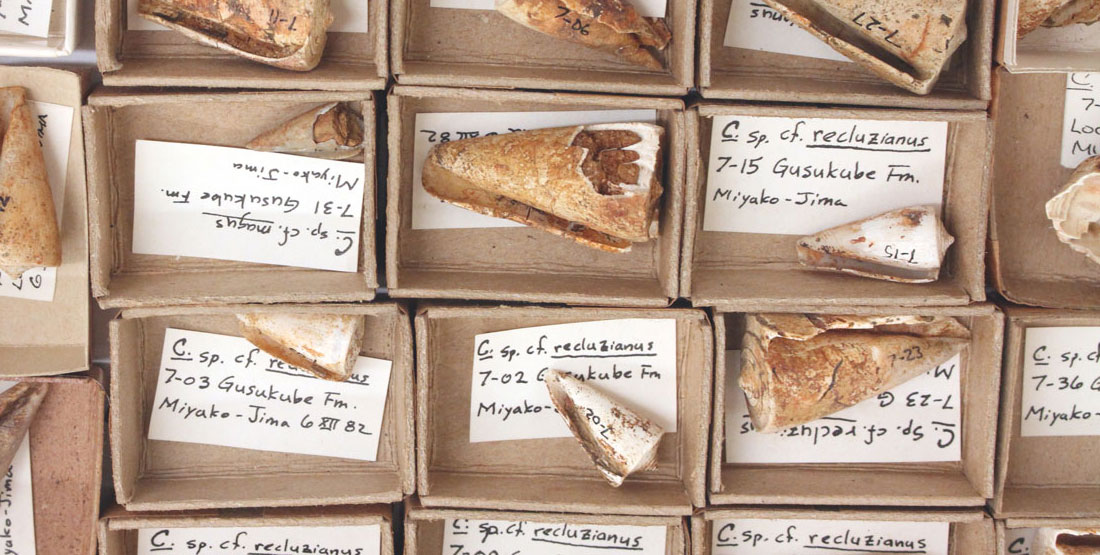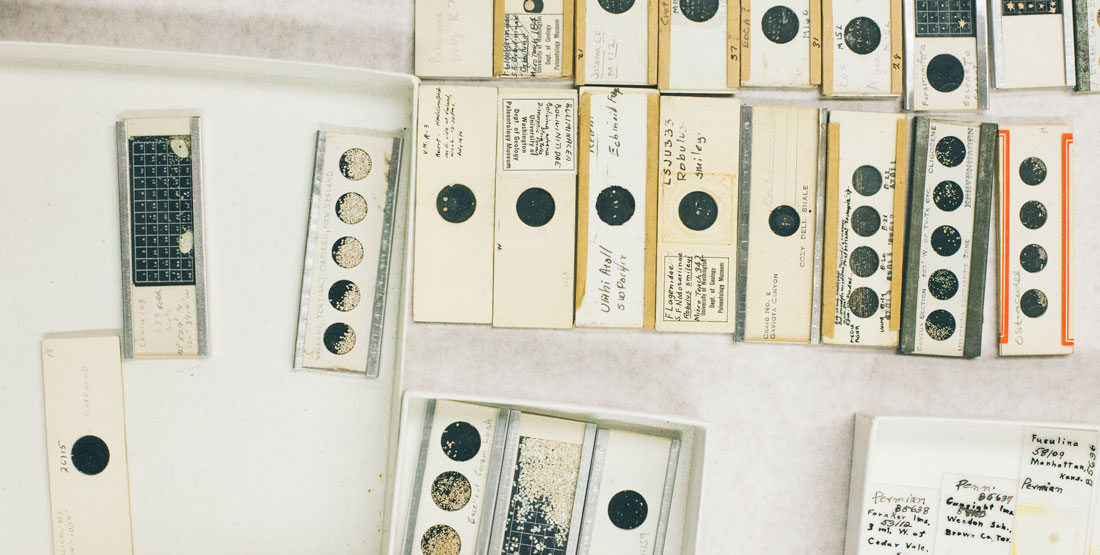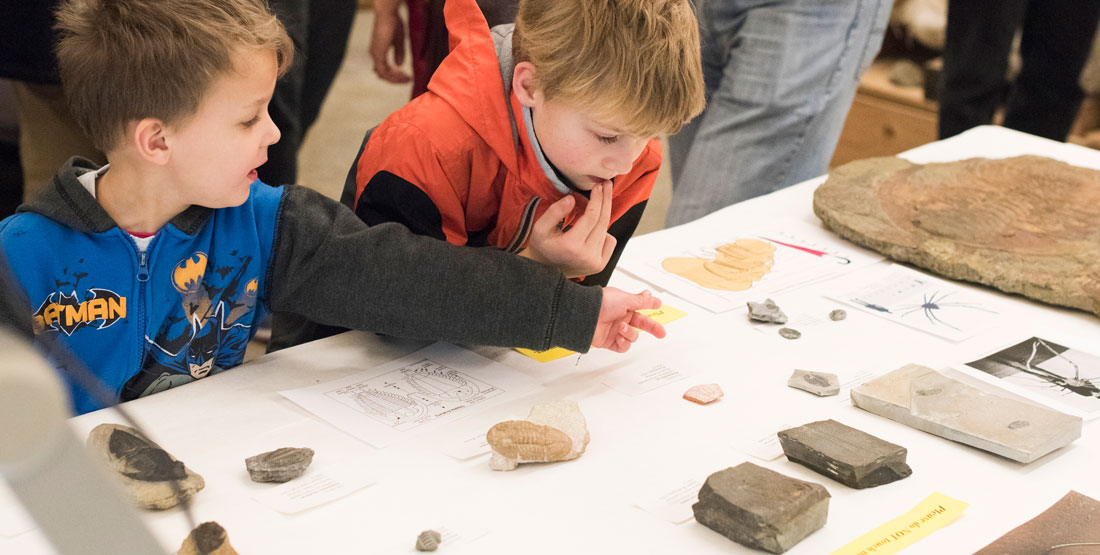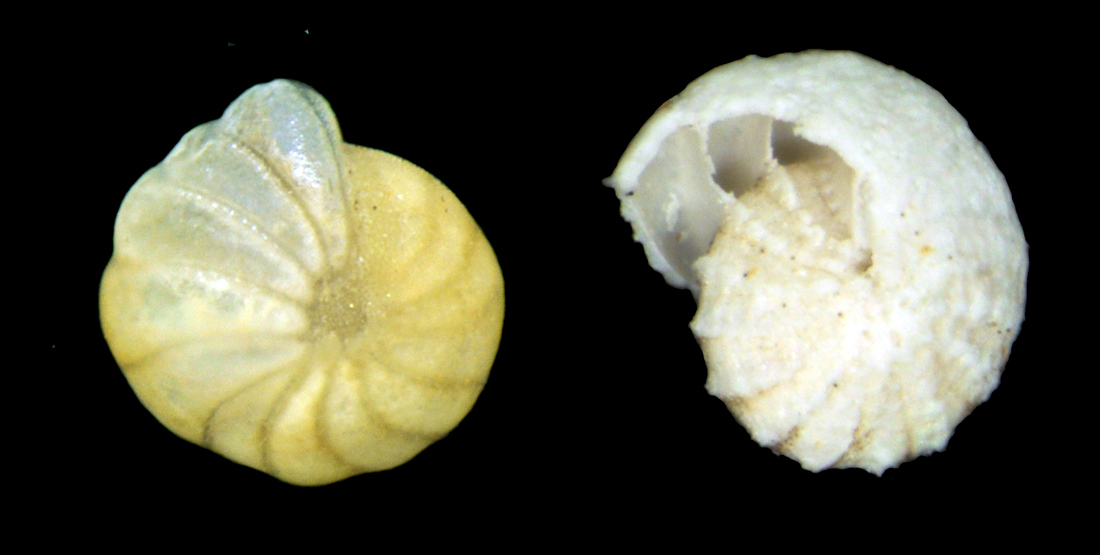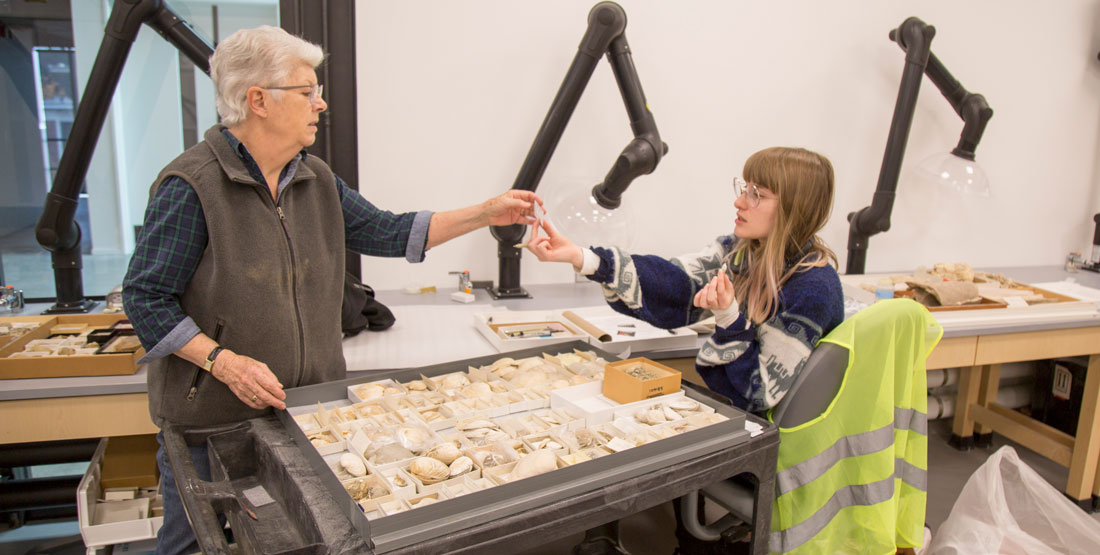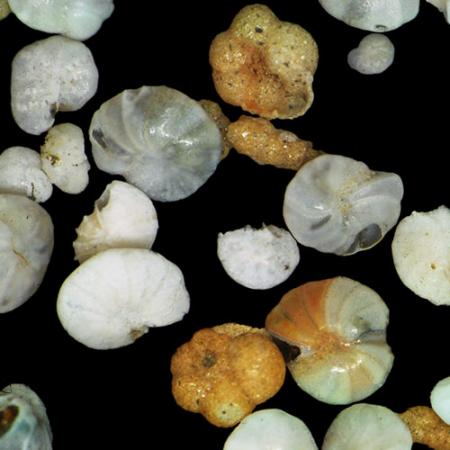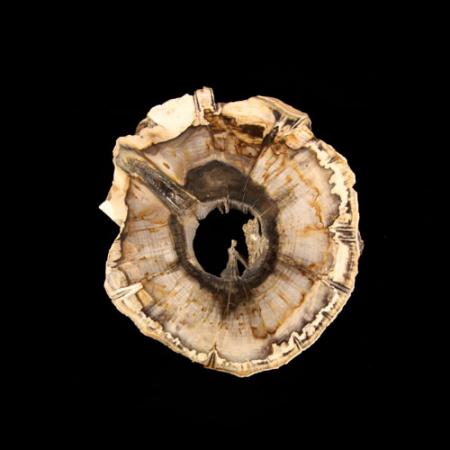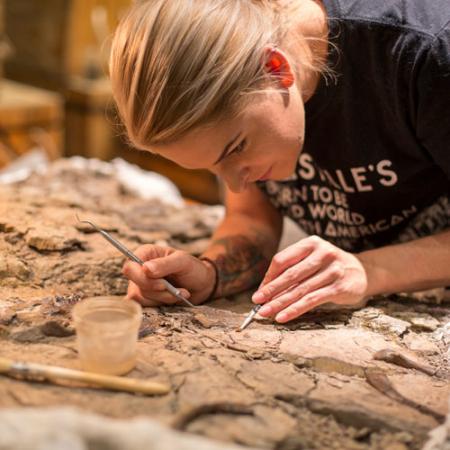Search the Collection
In total, the Paleontology & Geology Department cares for more than 4 million specimens of fossil invertebrates, vertebrates, plants, microfossils and trace fossils.
Collection Overview
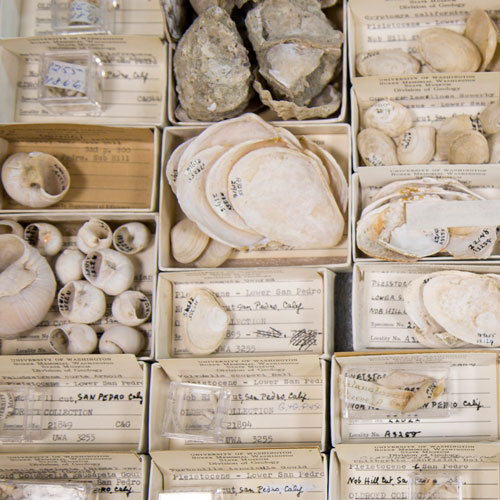
Invertebrate Fossils
About half of the invertebrate paleontology collections are molluscs (clams, snails, ammonoids and nautiloids) from the Cretaceous and Cenozoic of western North American, Oceania, and Asia.
In addition to the extensive Charles E. Weaver collection of Mesozoic South American material, there are also significant collections from western Europe. Recently donated material includes:
- Comprehensive collection of exhibit-quality decapod crabs and shrimps from the Pacific Northwest donated by Ross Berglund
- Large collections of mollusks from Fiji and Okinawa donated by Professor Emeritus Alan Kohn
- Mesozoic molluscs from the Western Interior Seaway, and Cenozoic marine fossils from the Pacfc Northwest, donated by David and Jo Nunnallee
- Exhibit-quality ammonites donated by Arthur and Glenda Israel, many of which will be on display in the new galleries.
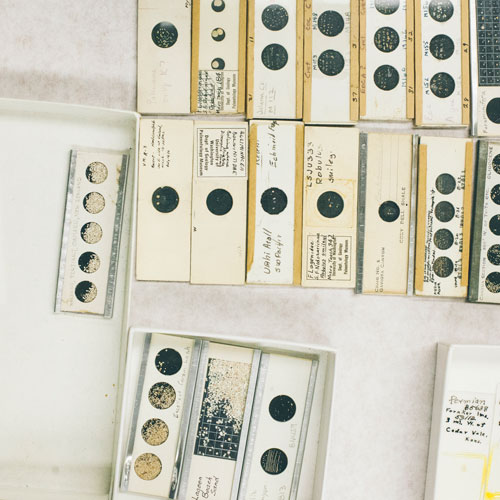
Microfossils
The marine microfossil collection consists primarily of Foraminifera. The bulk of the collection is from the Cenozoic of western North America and form the basis of biostratigraphic zonations along coastal Oregon and Washington. There is a rapidly growing collection of Recent Foraminifera from Puget Sound for current environmental research studies.
Each year we mentor undergraduate students doing original research with the Puget Sound Foraminifera project, an ongoing project to study what Foraminifera can tell researchers about environmental stressors in the Puget Sound. More information is also available in the Illustrated Guide to Benthic Foraminifera of Puget Sound.
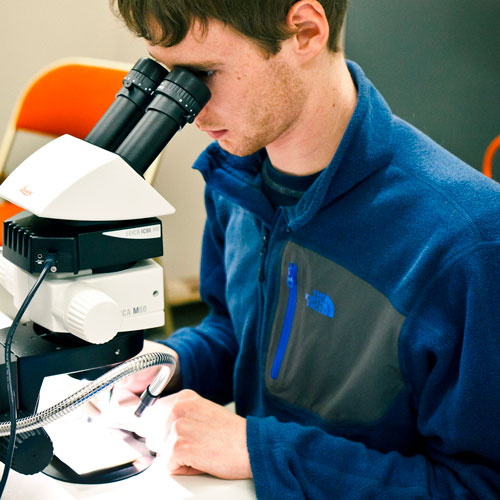
Our Research
Fossil Invertebrate animals and foraminifera are the basis of telling geologic time in the rocks, because some animal groups, such as trilobites and mollusks, evolved rapidly (geologically speaking) and only lived for relatively short periods. Thus, fossil species from each time slice are distinct, and once they become extinct they do not re-appear in the rocks.
Research into invertebrate animal groups involves both the biological implications of evolution and the patterns of distribution in time and space across the Earth. Recent research initiatives include:
- Working with geologists at the Washington Department of Natural Resources to pinpoint ages of rock sequences in southwestern Washington. Fossils show environments in which the rocks were deposited and the ages of the sedimentary layers.
- Working with a consortium of eight other paleontological museums on the west coast in a project called the Eastern Pacific Invertebrate Communities of the Cenozoic (EPICC). We have been recording specimens and fossil localities for all marine invertebrate fossils from Alaska to Chile, younger than 66 million years old, that are in our museum collections.
- Assessing and monitoring the health of Puget Sound through sediment samples and data made available by the Washington Department of Ecology for the Puget Sound Foraminifera Project to track changes in the condition of the water over time.
Questions & Answers
We’ve compiled answers to some of the most common questions we receive. Have another question that you need help with? Contact us.
I’m a researcher. Can I visit the collection?
The geology and paleontological collections are open to visiting researchers by appointment only. Interested researchers should should email the completed Research Visit Request form to the appropriate collections contact:
Invertebrate Paleontology & Geology Collections Research Visit
Ron Eng, M.S.
Invertebrate Paleontology & Geology Collections Manager
rceng@uw.edu
Paleobotany Collections Research Visit
Paige Wilson Deibel, Ph.D.
Paleobotany Collections & Lab Manager
wilsonp2 @uw.edu
Vertebrate Paleontology Collections Research Visit
Katherine L. Anderson, Ph.D.
Vertebrate Paleontology Collections Manager
katlande@uw.edu
Vertebrate Paleontology Collection Study Grant
This grant provides financial assistance for graduate students and post-doctoral researchers to study fossils in the Vertebrate Paleontology Collection at the Burke Museum. Learn more.
Can I borrow a specimen for my research?
The Geology & Paleontology Department will lend specimens to qualified institutions for exhibition, education or scholarly research. Specimens will not be lent to individuals except under special circumstances and with the approval of the Burke Museum Director.
Loan requests are considered on a case-by-case basis and approval is contingent upon such considerations as the structural stability of the specimens; security; exhibition or research conditions at the borrowing facility; insurance, crating, transportation, length of exhibition or research, and requirements for courier service. Please contact us for more information.
Can you help identify something?
If you think you have found a fossil, the Geology & Paleontology Department can help identify it on a time-available basis. Please note that we will not purchase your fossil or take it away. If you wish, and if your fossil is of scientific interest, you may donate it to the museum.
To get started, please fill out the Burke’s Online Identification Form.
Can I donate specimens to the collection?
The Geology & Paleontology Department considers donations on a case-by-case basis. Of particular interest are fossils from the Pacific Northwest or those belonging to a taxonomic group or geologic age that is not well represented in the collection. Not all fossils are appropriate to donate, especially those without basic locality data or clear ownership details.
Please contact us for more information.
Can I use an image of a specimen?
The Burke Museum retains the sole copyright for its holdings and all images depicting its holdings. Photographic images that are in the care of or are the property of the Burke Museum, or photographs, photocopies, or artistic renderings of collection items that are in the care of or are the property of the Burke Museum may not be used for commercial purposes without specific written permission.
Please contact us for more information.
Can I volunteer?
We couldn’t do what we do without volunteers! Visit our Volunteer page for more information about Burke Museum volunteer opportunities and to view current openings.
Our Team & Contact
Meet the people within the Burke Museum Invertebrate Paleontology & Micropaleontology team.
Have a general question?
Additional Resources
We've compiled several online resources from outside of the Burke Museum that may also be of interest.
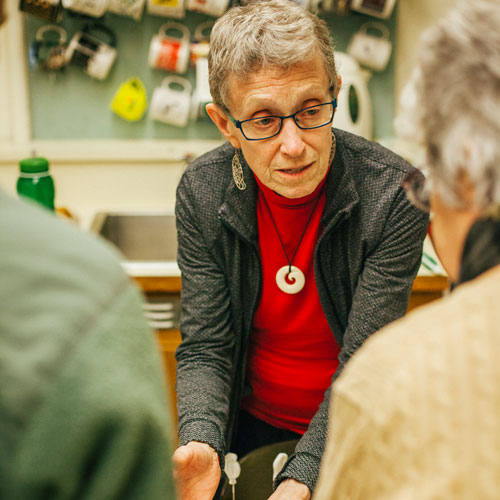
Support Invertebrate & Micropaleontology
Your gift makes it possible! We couldn't do what we do without donor support for collections care, research and public outreach.
